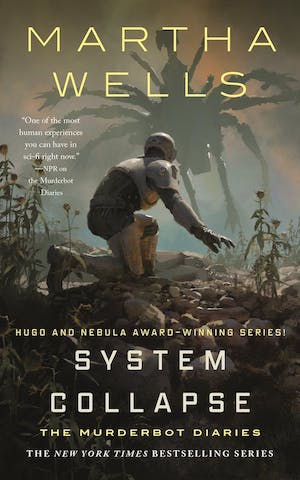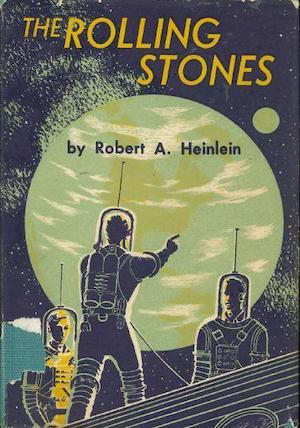In this bi-weekly series reviewing classic science fiction and fantasy books, Alan Brown looks at the front lines and frontiers of the field; books about soldiers and spacers, scientists and engineers, explorers and adventurers. Stories full of what Shakespeare used to refer to as “alarums and excursions”: battles, chases, clashes, and the stuff of excitement.
Robert Heinlein dipped his toes into many genres over the course of his long career, and The Rolling Stones is the closest he ever got to writing a sitcom. That’s why I avoided reading it when I first came across the book in my youth—I couldn’t imagine who would want to read the adventures of Leave it to Beaver in space, and I couldn’t get past the basic premise of a family buying a used spaceship and knocking around the solar system. But when I finally decided to read all the Heinlein juveniles, I found the Stone family to be good company, and discovered that I had been missing out on a fun and entertaining tale…
My first exposure to The Rolling Stones was through a used library edition of a dramatization by Full Cast Audio. This was a good way to experience it, as the cast did a good job making the banter of the family entertaining. My first time actually reading it, I borrowed a paperback copy from my son, and I later found it included in a Science Fiction Book Club omnibus edition entitled To the Stars.
I’ve found that Heinlein sometimes used his juvenile novels as a proving ground for ideas and characters that would later resurface in his grown-up novels. One example is the Martian race first described in Red Planet, which later pop up with similar appearance and paranormal powers in the book Stranger in a Strange Land (and of course those same Martians are met by young Lowell in The Rolling Stones). Also in The Rolling Stones we meet Grandmother Hazel Stone, who early in her life was a leader in the rebellion that freed the lunar republic from the authorities on Earth. A younger version of this character, while not an exact match for the Grandmother Stone, appears in Heinlein’s later novel of lunar rebellion, The Moon is a Harsh Mistress. The idea of families or clans operating space freighters was picked up again by Heinlein in another, later juvenile, Citizen of the Galaxy. And members of the Stone family appear in some of the later recursive Heinlein novels, where he began to bring characters and settings back from earlier works.
A subplot in The Rolling Stones also famously influenced an episode of Star Trek, “The Trouble with Tribbles.” The producers liked the script written by David Gerrold, but were so concerned with similarities between the promiscuously breeding tribbles and the Martian “flat cats” portrayed in The Rolling Stones that they sought permission from Heinlein before going forward with the episode.
Another subplot in The Rolling Stones is the dramatic series that the father, and later the rest of the family, is involved in writing. While I have not found confirmation for my suspicions, the tales in that series bear a resemblance to E. E. “Doc” Smith’s Lensman series, with a main character similar to the plucky lawman Kimball Kinnison. Which leads me to believe that “Doc”—one of the people to whom the book is dedicated—is Smith, and that Heinlein was poking a little fun at his friend.
About the Author
Robert A. Heinlein (1907-1988) was one of America’s most widely known science fiction authors, frequently referred to as the Dean of Science Fiction. I have often reviewed his work in this column, including Starship Troopers, The Moon is a Harsh Mistress, “Destination Moon” (contained in the collection Three Times Infinity), The Pursuit of the Pankera/The Number of the Beast, and Glory Road.
From 1947 to 1958, he also wrote a series of a dozen juvenile novels for Charles Scribner’s Sons, a firm interested in publishing science fiction novels targeted at young boys. These novels include a wide variety of tales, and contain some of Heinlein’s best work, and include Rocket Ship Galileo, Space Cadet, Red Planet, Farmer in the Sky, Between Planets, The Rolling Stones, Starman Jones, The Star Beast, Tunnel in the Sky, Time for the Stars, Citizen of the Galaxy, and Have Spacesuit Will Travel. This is not the first time The Rolling Stones has been reviewed on Tor.com, as the inimitable Jo Walton looked at the book over a decade ago.
Tramp Freighters
Tramp freighters have long been a trope in adventure fiction. They are generally small vessels that do not follow fixed routes, picking up cargo and sometimes a few passengers and taking them to a destination where they think another opportunity might await. Often, not being part of a larger organization and flying a flag of convenience, their crews are more diverse and less disciplined than the vessels sailing for the big shipping lines. And because they carry smaller, more high value cargoes, tramp freighters sometimes veer outside the boundaries of the law, and engage in smuggling or drug trade, either as a side operation or as their major source of revenue. Tramp freighters can provide a setting for adventure all by themselves, or else serve to take a protagonist to some mysterious foreign land where adventure awaits.
Traders and freighters have also been the subject of many science fiction stories. While it is difficult to imagine any extensive trade in an environment where spaceships are propelled only by reaction mass, or where travel between stars is limited by the speed of light, those constraints are often waved away by authors in search of a good story. It is very common for authors to posit jetless drives and FTL engines that make travel between planets or even stars no more difficult or costly than an ocean voyage on Earth—such devices make tramp freighters a possible means of transport in these tales. Examples of tramp freighters in space can be found in Andre Norton’s Solar Queen books, which follow an interstellar trading vessel; Sharon Lee and Steve Miller’s Liaden series, centered on a trading clan; A. Bertram Chandler’s John Grimes adventures; and Poul Anderson’s stories about the colorful adventurer and trader Nicholas van Rijn. In visual media we have seen two tramp freighters become quite popular: Han Solo’s Millennium Falcon from Star Wars, and Mal Reynolds’ Serenity from the TV show Firefly.
To refresh my memory on the topic of tramp freighters, I poked around on Wikipedia, and found an article on Tramp Trade, the generic term for this trading practice. To my surprise, in a section that gives examples of tramp trade in fiction, I found the following: “The Robert Heinlein novel The Rolling Stones concerns a family who buy a used spacecraft and travel the solar system, financed partly by trading goods to asteroid miners. The novel was derived from a shorter story titled Tramp Space Ship.”
The Rolling Stones
The book opens with twins Castor and Pollux Stone, made wealthy by inventions they had created at an early age, dickering at a used spaceship lot on Luna over the purchase of a ship. Their father, Roger, wants them to go to Earth to study at a major university, but they have a better idea—they plan to become traders who wander the Solar System. Roger Stone is an engineer and former mayor of Luna City who now writes a popular science fiction drama series, The Scourge of the Spaceways, and is at first appalled by the idea. But his headstrong mother, Hazel, immediately volunteers to go with the boys. Then the twins’ older sister Meade also volunteers to go. Even Roger’s wife, Doctor Edith Stone, indicates that she might be willing to travel. The only person not weighing in on this discussion is younger brother Lowell. Later that evening, it appears dad is giving in, because he asks if the twins have seen any larger ships that might be suitable…
The family then goes about buying and equipping a spaceship, which gives Heinlein a chance to in engage in lots of interesting exposition on how an atomic spaceship would operate. Heinlein has a gift for packaging exposition in a way that feels organic to the story rather than interrupting the action, and that gift is on good display here. We follow the family through lots of training, assigning roles, equipment repair, and bickering about duties and command structures. While Roger will be the captain, like the beleaguered fathers in so many sitcoms, you never feel he is solely in charge of the operation. Their first destination will be Mars, and the boys fill the cargo hold with used bicycles that they think will fetch a good price on the planet. The newly christened Rolling Stone takes off in the company of many other ships, orbital mechanics determining the fact that the most efficient routes occur within narrow launch windows.
Buy the Book


System Collapse
En route, on one of the nearby spaceships, the passenger liner War God, there is an outbreak of a mysterious and deadly disease. They desperately need a doctor, and Edith heeds the call of her Hippocratic Oath, despite Roger’s attempts to hold her back. Her family fears for her life for the rest of the trip back to Earth, but Edith’s presence ends up being the difference between life and death for the crew and passengers of the War God.
When they get to Mars, Castor and Pollux sell all of their bicycles but end up in trouble for not paying tariffs; their grandmother Hazel represents them in court, giving us a glimpse of her political skills and tenacity. We don’t see much of Meade, which is true for most of the book, although there are indications she is dating. Young Lowell gets a chance to meet a real Martian, and acquires a Martian flat cat, a pleasantly furry creature that seemingly exists only to be purr, eat, and be cuddly. After some discussion about destinations, the family decides to move on to the Asteroid Belt, carrying goods to a cluster of asteroids found to be rich in precious metals.
During their journey, Lowell’s flat cat has babies, and then the babies have babies. Everyone initially enjoys the extra company, but soon the ship is overrun with hungry flat cats. Eventually there are so many flat cats the family begins to worry about their food supplies. They begin to consider the unpleasant option of killing the excess flat cats, because research shows that flat cats breed to the maximum capacity of the food supply. But they also learn that the flat cats go into hibernation in the Martian winter when no food is available, so the excess flat cats are put in a chilly cargo hold.
Reaching the asteroids, they have many adventures among the colorful miners of the frontier. The flat cats prove to be a valuable commodity among the lonely miners, although they are only sold with strict dietary guidance. As a doctor, Edith is in high demand. Grandma Hazel and Lowell have a brush with death due to equipment failure caused by sloppiness on the part of the twins, who learn a valuable lesson. The family had intended to return home after their trip to the asteroids, but when they all sit down to discuss it, you can probably imagine what they decide. After all, they are called “the rolling Stones.”
Final Thoughts
The Rolling Stones is an enjoyable entry in Heinlein’s juvenile series, refreshingly free of violence and warfare, especially when contrasted with the previous volume, Between Planets. The bickering among the family members is entertaining, and feels true to life. And their journey gives a convincing and imaginative view of what the solar system might be like if mankind spreads beyond the Earth.
And now I look forward to hearing from you: What do you think of The Rolling Stones? How does it stack up against Heinlein’s other juveniles? And as a fan of stories involving traders in space, I’d enjoy hearing about other such stories you may have encountered.
Alan Brown has been a science fiction fan for over five decades, especially fiction that deals with science, military matters, exploration and adventure.










